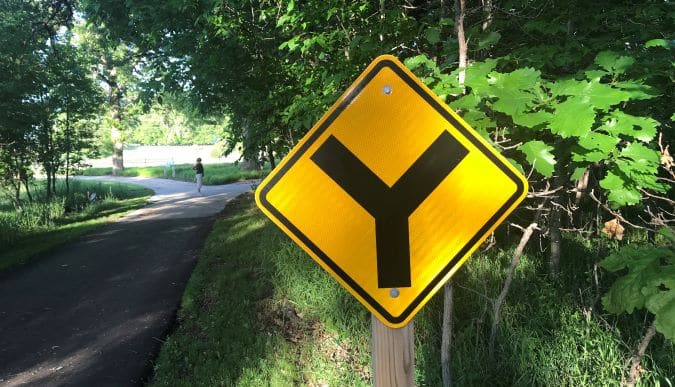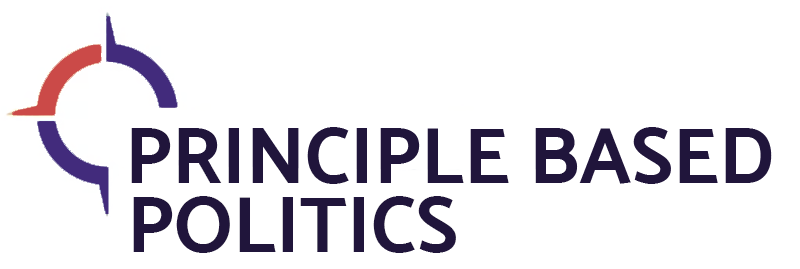
24 Sep America’s Fork in the Road
Today we will test the truth of the saying that “a picture is worth a thousand words.” This post, which contains close to 1,000 words and exactly one photograph, will explore the idea that what may look like an America headed farther and farther apart on two separate paths may actually be a country coming together.
A fork in the trail can be the point at which two paths meet, or the point at which a trail splits, as we will explain. It all depends on the direction one is going.
The photo above makes that same point with zero words. Feel free to judge for yourself whether the textual explanation below adds worth to the picture.
Less Divided than Things May Appear
According to a recent poll, 70 percent of Americans believe the people of our country have more in common with one another than many of us think. They likely are correct.
Politically, there are indications that the people of the United States generally do agree on many topics. For example, 93 percent of poll respondents believe we have a right to clean air and water, with 87 percent believing it is the government’s responsibility to ensure that. Similarly, 92 percent believe we have a right to quality kindergarten through twelfth-grade education, with 79 percent agreeing it is the government’s duty to provide such an education. Another 87 percent assert the government is obligated to protect the country’s citizens.
Even on supposedly “divisive issues” like gun control, a strong agreement exists on specifics like the government’s need to keep guns out of the hands of the mentally ill (more than 85 percent of the members of each political party agree on that) and a requirement that buyers at gun shows and private sales be subjected to background checks (70 percent of Republicans and 92 percent of Democrats agree, for a cumulative total of more than 80 percent).
While typically not thought of as a unifying force, Donald Trump did cause the Republican Party to be less a party of the rich and elite, and more the party of the worker. At the same time, whereas business leaders and suburbanites in the past may have been less likely to vote for a Democrat candidate in a presidential race, that also changed in the Trump elections. By this point in our national history, it seems no segment of voters is absolutely and unmovably committed to either party.
In fact, polls today say more than 40 percent of Americans consider themselves to be “independent” voters. In other words, more people identify themselves as “independent” than with either major party.
All of this shows that voters themselves—as opposed to the media and the party leaders—see common ground on the horizon.* Voters are not wedded to a political party, and those who do favor one party over the other certainly are not adherents of every fringe faction within it. Despite the forces trying to pull them toward the extremes, the majority of voters in fact seem disgusted by those efforts and want that fork in the road to be bringing them back onto a more unified path.
*The media and many politicians often stand to gain by driving wedges between us.
Although events of recent years have caused or exacerbated some divisions in America, we should remember that this is not unusual or permanent. At various periods in its history, our country has strayed in opposite directions (for example, during the Civil War), and we, the people, have come back together stronger than before. There continues to be ample reason for political hope.
Headed Toward the Same Goal
One final polling figure: Nearly 70 percent of the people in this country agreed during the last year with the statement that “the government does not represent the America that I love.” That figure shows a disconnect with our leaders, obviously, but it does not really mean Americans are on two separate paths. Instead, this result indicates that there is an America we, the voters, do love, and we expect our government to represent that vision.
What is that unified vision? What are the points of consensus that our federal government should represent? Principle Based Politics believes the vast majority of us want to see a government that leads the United States in this direction:
- Equal treatment of all who play by the rules
- The government does not interfere unnecessarily in our businesses or personal lives
- Generosity with America’s vast financial resources
- Freedoms are honored
- Clear and reliable information provided by the government, particularly with respect to health matters
- Laws enforced vigorously
- Taxes that are clear, fairly apportioned based on income, and at rates no higher than is necessary for the government to pay its bills
- A safety net for children and people who have health problems that they cannot afford to treat
- Protection from threats abroad, with a strong military so we do not need to use it
- Honest leaders with integrity
This list is not exhaustive, as there are many other “big picture” items and principles on which our citizens agree.
When you look at it this way, that “fork” in the path ahead actually may be laying more like two spoons than like two knives tearing America apart.
Written by Quentin R. Wittrock, founder of Principle Based Politics.
Look for his posts twice each week, as this blog will explore and promote the idea of principle in politics, both as to individual elected leaders and our federal government as an institution.


Anonymous
Posted at 21:46h, 21 DecemberBefore you can accurately turn the Y sign on its head in order to be coming together, you must turn it around